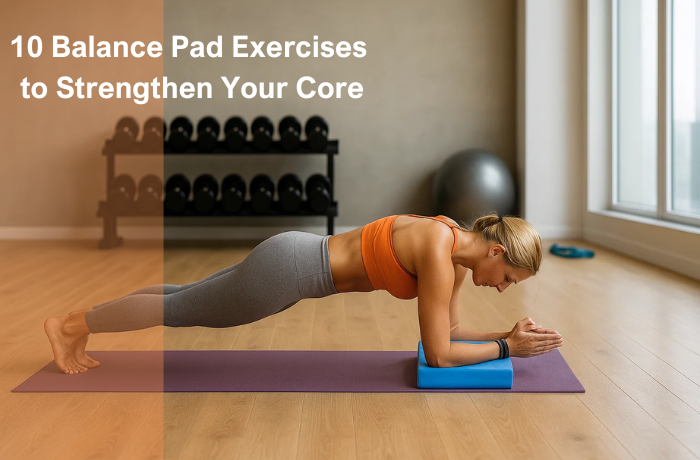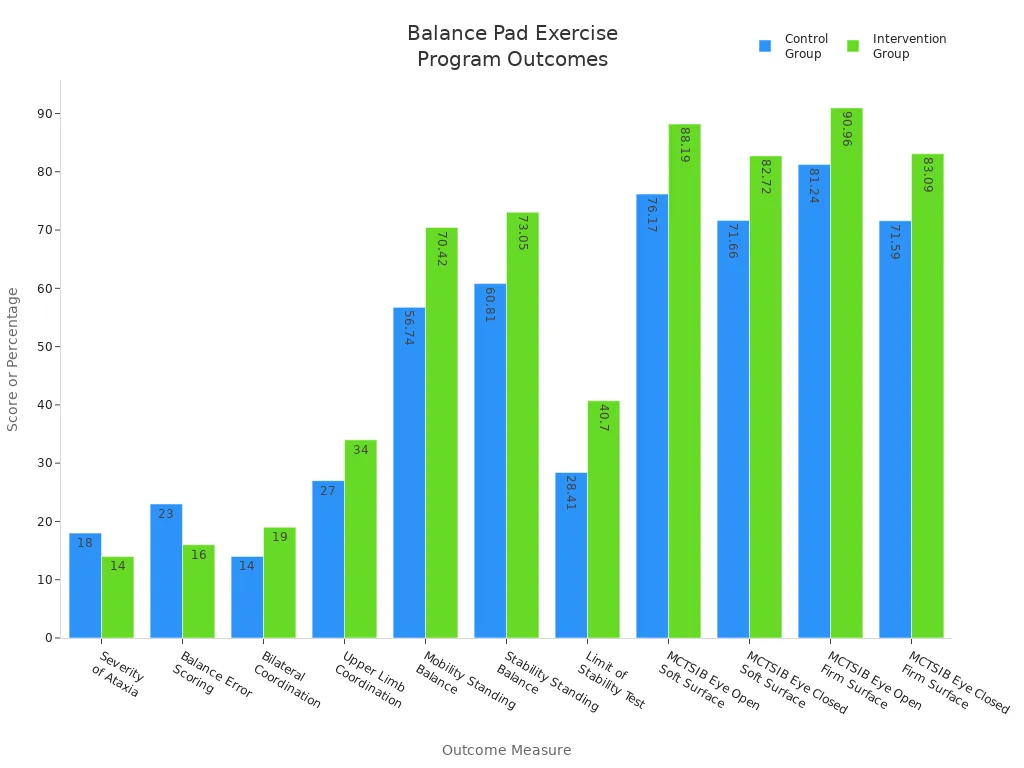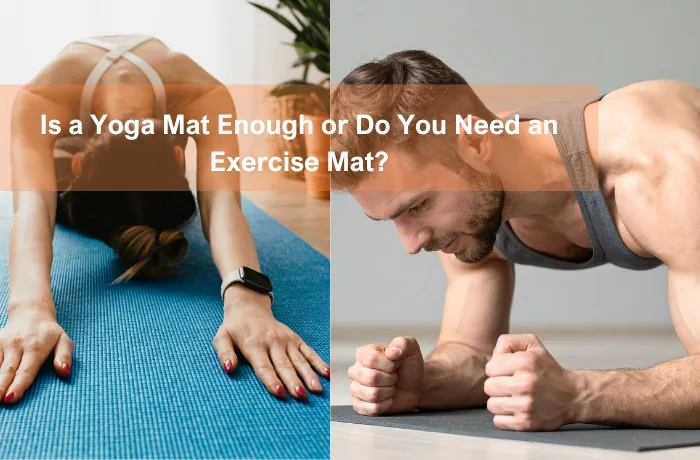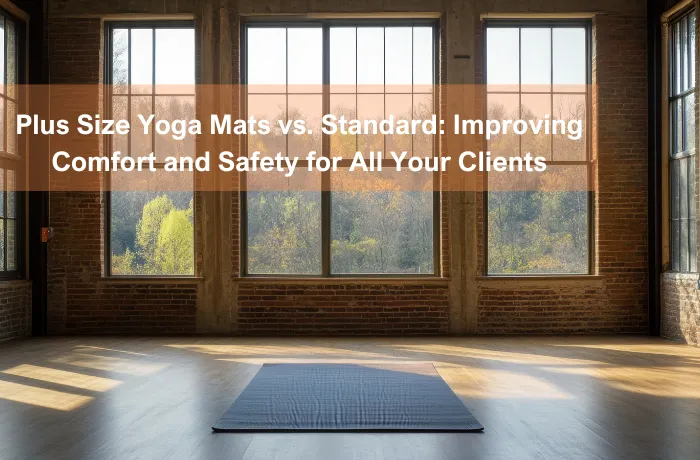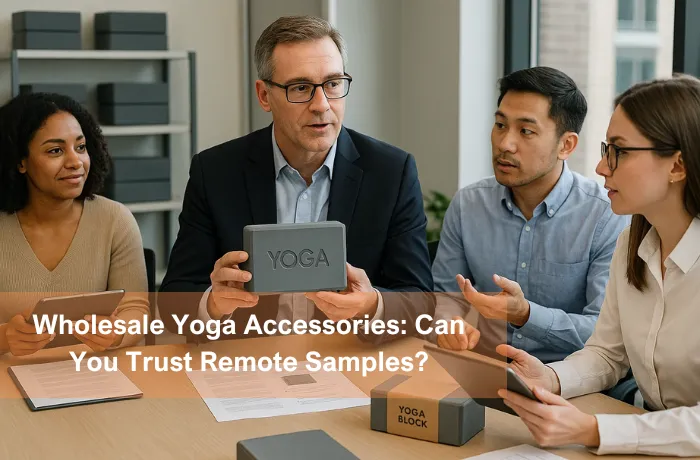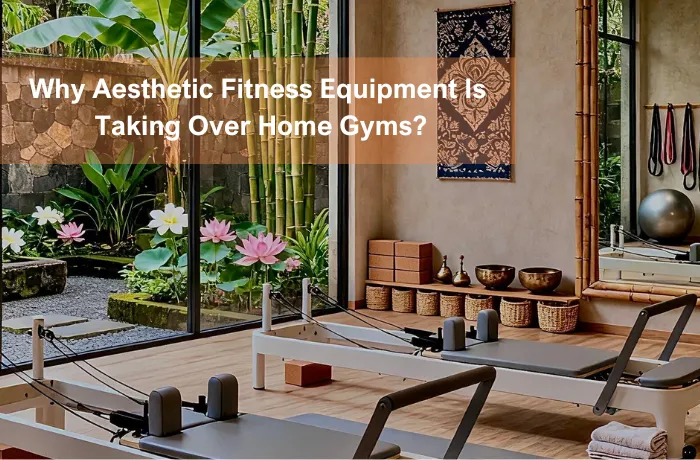
Are you searching for the best balance pad exercises to make your core stronger? You are in the right spot! Studies show these exercises can help you get better balance, move better, and make your core stronger. This works for everyone, no matter your age or how fit you are. Here are some of the best exercises:
- Basic Balance Hold
- Single-Leg Stance
- Plank Variations
- Squats and Lunges on a balance pad
- Dynamic movements
Studies show that using a balance pad for training helps people heal after injuries, get better balance, and feel stronger every day.
Key Takeaways
- Balance pads help you get stronger and improve balance. They also help you move better. People of all fitness levels can use them. Using a balance pad makes your muscles work more to stay steady. This helps you become more stable and avoid getting hurt. Start with easy exercises first. Use a chair or wall for support to stay safe. Try doing planks, single-leg stands, and squats on the pad. These moves help you build a strong and steady core. Practice often and pay attention to how your body feels. Go slow and steady to get better results and move well for a long time.
Balance Pad Basics
What Is a Balance Pad?
A balance pad is a soft foam mat that helps you work on your balance and core strength. You usually stand, sit, or kneel on it while doing exercises. The foam feels squishy under your feet, which makes your muscles work harder to keep you steady. Most balance pads are about 2.5 inches thick and measure around 16 by 20 inches. You can find larger pads if you want more space for movement.
Here are some features you might notice in a high-quality balance pad:
- Made from closed-cell foam that is soft but keeps its shape
- Slip-resistant surface for safety during workouts
- Water-resistant and easy to clean
- Some pads have a textured or waffle surface to wake up the nerves in your feet
- Durable and does not absorb dirt or moisture
- Can be used barefoot for better results
You can use a balance pad for many activities, like yoga, pilates, or even physical therapy. Some people even use them as seat cushions to help with posture.
Why Use a Balance Pad?
You might wonder why you should add a balance pad to your routine. When you stand or move on a balance pad, your body has to work harder to stay steady. This helps you build stronger muscles in your core, legs, and ankles. It also trains your brain and body to react quickly if you start to lose your balance.
Research shows that using a balance pad can improve your balance and make your muscles stronger. Athletes use them to get better at their sports, but you do not have to be an athlete to benefit. People recovering from injuries or surgery often use a balance pad in physical therapy. Studies also show that balance pad exercises help your body learn to adjust to wobbly surfaces, which can lower your risk of falling.
If you want to boost your stability, coordination, and core strength, a balance pad is a simple tool that can make a big difference.
Core Strength Benefits
Stability and Coordination
When you work on your core strength, you help your body stay steady and move with control. Your core muscles connect your upper and lower body. They help you twist, bend, and stand tall. Every time you reach for something or turn quickly, your core muscles jump into action.
- Core strength powers your movements in sports and daily life.
- You use your core muscles when you sit, stand, or even do chores.
- Good core strength helps you keep your balance and avoid falls.
- Strong core muscles support your posture and make breathing easier.
Studies show that balance training on a soft surface, like a balance pad, makes your core muscles work even harder. This kind of training helps your brain and body learn to work together. You get better at moving smoothly and staying steady, even when things get tricky. Athletes and beginners both see better balance and coordination after adding core exercises to their routines.
Tip: Try balance training with a friend. You can cheer each other on and make it more fun!
Injury Prevention
Building core strength does more than help you move well. It also protects you from getting hurt. When your core muscles are strong, they hold your body steady and help you move safely. This lowers your risk of injuries, especially in your back, hips, and knees.
- Core stability keeps your spine safe during lifting and twisting.
- Strong core muscles help you avoid back pain, which is common for many people.
- Balance training and core exercises help prevent falls, especially as you get older.
- Good core strength supports your joints and helps you move with control.
Sports medicine experts say that people with weak core muscles have a higher chance of getting hurt. When you train your core, you build a solid base for every movement. This makes daily tasks and sports safer and easier.
Safety Tips
Setup and Positioning
Getting started with a balance pad is simple, but you want to make sure you stay safe and get the most out of your workout. Here are some steps to help you set up and position yourself:
- Place your balance pad on a flat, non-slip surface. Make sure you have enough space around you.
- Stand close to a wall or keep a sturdy chair nearby. This gives you something to grab if you feel unsteady.
- Put your feet about shoulder-width apart on the pad. This helps you find a strong base.
- Keep your knees slightly bent and your back straight. This makes it easier to balance and move.
- Center your weight over the pad and relax your shoulders. Try to stay loose and avoid tensing up.
- Extend your arms out to the sides if you need extra help with balance.
- If you feel comfortable, try doing the exercises barefoot. This can help your feet get stronger and improve your balance.
Tip: Always start slow and focus on your form. Rushing can lead to slips or falls.
Precautions for Beginners
If you are new to balance pad exercises, take a few extra steps to stay safe and build confidence. Here is a quick table to guide you:
| Precaution Category | Description |
|---|---|
| Start with Basics | Begin with simple moves that match your fitness level. Skip advanced exercises at first. |
| Gradual Progression | Move from stable surfaces to the balance pad slowly. Give your body time to adjust. |
| Proper Warm-up | Warm up for 5-10 minutes with light movement and stretches before using the pad. |
| Maintain Proper Form | Focus on good posture and technique to avoid injury. |
| Use Support | Stay near a wall or chair, or ask someone to spot you if you feel wobbly. |
| Safe Environment | Clear the area of anything you could trip over. |
| Listen to Your Body | Stop if you feel pain, dizziness, or too tired. Never force a movement. |
| Consult Professionals | Ask a trainer or doctor for advice if you have health concerns. |
| Avoid Overtraining | Don’t push too hard. Let your body get used to the new exercises. |
| Visual and Task Progression | Start with eyes open. Try closing your eyes only when you feel steady and ready. |
Remember, everyone learns at their own pace. Progress slowly, rest between sets, and always put safety first when using a balance pad.
Top 10 Balance Pad Exercises

Ready to fire up your core strength and balance? Grab your balance pad and try these top 10 balance pad exercises. Each one helps you build strong core muscles and better stability. You can mix and match these moves or do them all in one workout.
Plank
The plank is a classic move for core strength. Doing it on a balance pad makes your core muscles work even harder.
How to do it:
- Place your balance pad on the floor.
- Get into a plank position with your hands under your shoulders and your knees under your hips.
- Step one leg back, then the other, so your body forms a straight line from head to heels.
- Press your hands into the pad and flatten your shoulder blades.
- Keep your abs and glutes tight.
- Try lifting one leg off the floor, then switch legs.
Tip: Start by holding the plank for 10 seconds. Work up to 60 seconds as you get stronger.
This exercise targets your entire core. The soft pad makes you wobble, so your abs, back, and glutes have to work together to keep you steady.
Single-Leg Stand
Single leg balance is a simple but powerful move. It helps you build strength in your core and legs.
How to do it:
- Stand on the balance pad with both feet.
- Slowly lift one foot off the pad and hold your balance.
- Keep your hips level and your core tight.
- Hold for 15-30 seconds, then switch legs.
If you want more of a challenge, close your eyes or move your arms overhead.
This exercise wakes up your core muscles and helps you stay steady on your feet.
Bird Dog
Bird dog is great for your back and abs. The balance pad adds a fun twist.
How to do it:
- Kneel on the balance pad with your hands under your shoulders.
- Extend your right arm forward and your left leg back.
- Hold for a few seconds, then return to start.
- Switch sides.
Try to keep your hips and shoulders level. If you want it easier, just lift your arm or leg, not both.
Bird dog works your core strength by making you balance while moving your arms and legs.
Glute Bridge
Glute bridges help your hips, glutes, and core muscles.
How to do it:
- Lie on your back with your feet on the balance pad and knees bent.
- Press your feet into the pad and lift your hips up.
- Squeeze your glutes and hold for a few seconds.
- Lower your hips back down.
You can make it harder by lifting one leg off the pad.
This move targets your lower back, glutes, and abs. The pad makes your core work to keep your hips steady.
Side Plank
Side planks are awesome for your obliques and hip muscles.
How to do it:
- Place your elbow on the balance pad and stack your feet.
- Lift your hips so your body forms a straight line.
- Hold for 15-30 seconds, then switch sides.
If you need to, drop your bottom knee to the floor for support.
Side planks target the side of your core and help you build strong, stable hips.
Russian Twist
Russian twists fire up your obliques and help you rotate with control.
How to do it:
- Sit on the balance pad with your knees bent and feet flat.
- Lean back until your torso is at a 45-degree angle.
- Clasp your hands and extend your arms in front of you.
- Brace your core and twist slowly to one side, then the other.
Note: Move slowly and keep your knees steady. Twist through your chest, not your lower back.
This exercise targets your obliques and deep core muscles. The balance pad makes you work harder to stay upright.
Mountain Climber
Mountain climbers get your heart pumping and challenge your core.
How to do it:
- Place your hands on the balance pad and get into a plank position.
- Bring one knee toward your chest, then switch legs quickly.
- Keep your hips low and your core tight.
The soft pad makes your shoulders and core muscles work extra hard to keep you stable. You will feel your abs and shoulders burn as you move.
Squat
Squats on a balance pad help you build strong legs and a solid core.
How to do it:
- Stand on the balance pad with your feet hip-width apart.
- Lower your hips back and down like you are sitting in a chair.
- Keep your chest up and your core tight.
- Stand back up.
Try holding your arms out in front for balance. If you want more of a challenge, try a single-leg squat.
Squats on a balance pad force your core muscles to keep you steady as you move up and down.
Lunge
Lunges on a balance pad take your balance and core strength to the next level.
How to do it:
- Stand with one foot on the balance pad and the other behind you.
- Lower your back knee toward the floor, keeping your front knee over your ankle.
- Push through your front foot to stand back up.
- Switch legs.
Doing lunges on a balance pad makes your core work harder to keep you from tipping over. Your abs, hips, and legs all have to work together to stay balanced.
Dead Bug
Dead bug is a fun way to train your core muscles and coordination.
How to do it:
- Lie on your back with your arms straight up and your knees bent at 90 degrees.
- Place the balance pad under your lower back for extra challenge.
- Slowly lower your right arm and left leg toward the floor.
- Return to start and switch sides.
Keep your lower back pressed into the pad. Move slowly and with control.
Dead bug targets your deep core muscles and helps you build better control over your movements.
Try these balance pad exercises two or three times a week. Mix them into your routine for a strong, stable core and better balance every day!
Balance Exercises for Seniors
Gentle Movements
You can boost your stability and confidence with gentle balance exercises for seniors. These movements help you stay steady, improve your posture, and keep you moving safely every day. Many seniors find that regular practice leads to better mobility and more independence. You do not need fancy equipment—just a balance pad and a safe space.
Here are some easy exercises you can try:
- Side-to-Side Steps: Stand on your balance pad. Shift your weight to one foot, lift the other leg, and hold for a few seconds. Switch sides and repeat.
- Toe Raises: Stand tall on the pad. Rise up onto your toes, then lower back down. This move wakes up your ankles and calves.
- March in Place: Stand on the pad and lift your knees one at a time, like you are marching. Swing your arms for extra balance.
- Step-Ups: Place the pad on the floor. Step up with one foot, then bring the other foot up. Hold, then step down and repeat.
Tip: Always keep a sturdy chair or wall nearby for support. Safety comes first!
Doing these exercises every day can help with fall prevention and make daily tasks easier. You might even notice better focus and a happier mood.
Progression Tips
You can make progress by taking small steps. Start with simple moves and add new challenges as you get stronger. Here are some ways to safely advance:
- Begin near a chair or wall for support.
- Try basic weight shifts before moving to the balance pad.
- Once you feel steady, remove your support or close your eyes for a few seconds.
- Add fun challenges, like naming your favorite foods while balancing.
- Change the speed of your movements to keep things interesting.
- Practice about three times a week for a few weeks before trying harder exercises.
- Track your progress with simple tests, like timing how long you can stand on one leg.
Note: Always listen to your body. If you feel tired or unsteady, take a break. Ask your doctor before starting new exercises, especially if you have health concerns.
With patience and practice, you will notice better balance, more strength, and greater confidence in your mobility.
Balance Board Exercises vs. Balance Pad
Key Differences
You may wonder how balance board exercises are different from balance pad moves. Both help you get stronger and improve your balance, but they do it in their own ways.
Balance board exercises use a hard surface that moves and wobbles. When you stand on the board, your body makes small moves to keep you steady. This makes your ankles, thighs, and core muscles work all the time. Studies show you can make balance board workouts harder as you get better. You can start with easy moves and try tougher ones later. The board’s movement makes your muscles work more, especially in your ankles and legs.
Balance pad exercises use a soft foam pad. When you stand, sit, or kneel on it, the pad sinks a bit. Your body has to work to stay up, but it is not as hard as the board. The pad helps wake up your stabilizer muscles and helps you know where your body is. You get a gentle challenge that is good for beginners or people who want a safer way to train.
Here’s a quick table to show the main differences:
| Feature | Balance Board Exercises | Balance Pad Exercises |
|---|---|---|
| Surface | Hard, unstable | Soft, foam |
| Muscle Engagement | Ankles, thighs, core (high) | Core, stabilizers (moderate) |
| Difficulty Progression | Easy to advanced | Mostly gentle |
| Safety | Needs caution | Safer for most people |
| Best For | Athletic training, rehab | Beginners, seniors, rehab |
Tip: If you want a bigger challenge, try the balance board. If you want to start easy, use the pad.
When to Use Each?
You might ask, “Which one should I use?” The answer depends on what you want and how fit you are.
Pick balance pad exercises if you are new to balance work or want something easier. The pad works for sitting, kneeling, or standing moves. It is great for beginners, seniors, or people coming back from an injury. You get a safe way to build strength and feel more sure before trying harder things.
Choose balance board exercises when you want to push yourself more. Balance board training is good for athletes, people in rehab, or anyone who wants stronger ankles and a stronger core. You can use balance board workouts to make your muscles work harder and get faster at reacting. The board lets you try both still and moving exercises, so you do not get bored.
Fitness experts say balance board training is best for people who feel steady and want to get better. If your ankles are weak or your joints hurt, start with the pad. When you feel ready, add balance board exercises for a bigger challenge.
Remember: Always listen to your body. Start slow and use support if you need it. Balance board training and workouts can be fun and helpful if you use them safely.
Workout Tips
Frequency
How often should you do balance pad exercises for the best results? The answer depends on your fitness level and goals. You want to build strength, but you also need to give your body time to recover. Here’s a quick guide to help you plan your week:
| User Level | Recommended Frequency | Session Duration | Focus / Notes |
|---|---|---|---|
| Beginners | 2 to 3 times per week | 5 to 10 minutes | Build basic stability and get used to the pad. Start with simple standing exercises. |
| Intermediate Users | 3 to 5 times per week | 15 to 20 minutes | Add gentle movements like squats and lunges to boost core strength. |
| Advanced Users | 4 to 7 times per week | 20 to 30+ minutes | Try dynamic, complex moves like single-leg balance or weighted squats. |
| Seniors/Rehab | At least 3 times per week | 5 to 15 minutes | Focus on slow, controlled movements. Always follow your doctor’s advice. |
Tip: Consistency matters more than doing long workouts. Listen to your body and rest when you need it.
Combining with Other Core Workouts
You can get even more out of your balance training by mixing it with other core exercises. This keeps your routine fresh and helps you build strength all over.
- Add balance pad moves to your regular core workout. Try planks, Russian twists, or crunches on the pad.
- Pair balance exercises with squats or push-ups for a full-body challenge.
- Use the pad during HIIT sessions to raise your heart rate and work your core at the same time.
- Mix static holds (like single-leg stands) with dynamic moves (like lunges or step-ups) for better results.
- Try closing your eyes or changing your head position to make exercises harder and train your balance system.
- Adjust the difficulty by standing on one leg or adding light weights.
- Use other tools like BOSU balls or medicine balls to keep things interesting and target different muscles.
Note: Always focus on good form. Quality matters more than speed or how many reps you do.
With these tips, you can make balance training a fun and powerful part of your fitness routine!
You will get better at staying steady and moving smoothly if you keep doing balance pad exercises.
Studies say that practicing often helps you move with more control. You need to keep practicing to see big changes that last. Here are some ways to help you keep going:
- Make small goals and cheer for yourself when you reach them
- Change your exercises so you do not get bored
- Ask friends or family to join you and help you
Go at a speed that feels right for you and add balance pad training to your week. This will help you get stronger and have better balance!
FAQ
How often should you use a balance pad?
You can use a balance pad two or three times a week. Start slow and add more days as you get stronger. Listen to your body and rest if you feel tired.
Can you use a balance pad if you have bad knees?
Yes, you can! Just pick gentle exercises and keep a chair nearby for support. If your knees hurt, stop and talk to your doctor before trying again.
What should you wear for balance pad workouts?
Wear comfortable clothes that let you move easily. Bare feet or shoes with flat soles work best. Avoid socks because they can make you slip.
How do you clean a balance pad?
Wipe your balance pad with a damp cloth after each use. Use mild soap if it gets dirty. Let it air dry before you put it away.
Can kids use a balance pad?
Kids can use a balance pad with adult supervision. Start with easy moves and make sure the area is safe. Balance pads help kids build strength and coordination.

